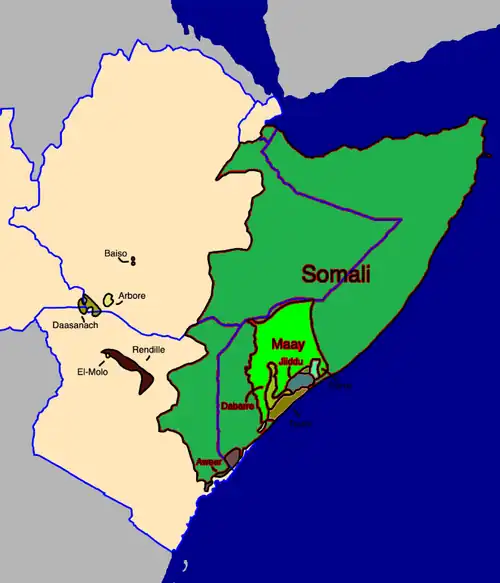Macro-Somali languages
| Macro-Somali | |
|---|---|
| Somaloid, Eastern Omo–Tana, Sam | |
| Geographic distribution | Somalia, Djibouti, Ethiopia, Kenya |
| Linguistic classification | Afro-Asiatic
|
| Subdivisions | |
| Language codes | |
| Glottolog | east2653 |
 | |
The Macro-Somali or Somaloid languages, or (in the conception of Bernd Heine, who does not include Baiso[2]) Sam languages, are a branch of the Lowland East Cushitic languages. They are spoken in Somalia, Djibouti, eastern Ethiopia, and northern Kenya. The most widely spoken member is Somali.[3]
Languages
Heine, 1978
The primary division is between Rendille versus the remaining languages, for which Heine proposes the terms "Eastern Sam" or "Dad".[4] In this proposal, Baiso forms a Northern branch of Omo–Tana.
Blench, 2006
Within Blench's proposal, the primary division of Macro-Somali is first between Baiso, Sam, and Somali. Then within Sam, the primary split is between Rendille and Aweer. Girirra is left unclassified within Lowland East Cushitic.[5]
Sound correspondences
The following sound correspondences hold between Rendille, Aweer and Somali:
| Proto-Sam | Rendille | Aweer | Somali | notes |
|---|---|---|---|---|
| *b | b | b | b | |
| *d | d | d | d | |
| *g | g | k, -g- | g | |
| dʒ | ʃ | dʒ ⟨j⟩ | Before the vowel *i (palatalization). | |
| *t | t | t, -d- | t, -d- | |
| *c | tʃ | ʃ, -y- | ʃ ⟨sh⟩, -j- ⟨y⟩ | |
| *k | k | k, -g- | k, -g- | |
| ʃ | Before the vowel *i. | |||
| *ɗ | ɖ | ɗ, -r- | ɖ ⟨dh⟩ | Continues Proto-East Cushitic implosive *ɗ. |
| *q | x | ʔ | q | Continues Proto-East Cushitic ejective *kʼ. |
| *f | f | f | f | |
| *s | s | s | s | |
| *ħ | ħ | ħ, -h- | ħ ⟨x⟩ | |
| *h | h, -ħ- | h | h | |
| *z | j | d | d | |
| *ʕ | ħ | ʔ | ʕ ⟨c⟩ | |
| *ʔ | ħ | ʔ | lost | |
| *m | m | m, -n | m, -n | |
| *n | n | n | n | |
| *l | l | l | l | |
| *r | r | r | r | |
| *w | w | w | w, -b- | |
| *j | j | j | j ⟨y⟩ |
The Eastern Sam or Dad group is characterized by the following four changes:[6]
- The voiceless stops *t, *c, *k became voiced *d, *j, *g when following a vowel.
- Elsewhere, *c becomes a fricative *ʃ.
- *z > *d.
- *m > *n at the end of a word.
In Boni, several consonant clusters simplify:[7]
- *mb, *nɗ, *ng > m, n, ŋ
- *ns > s
- *ng before *i > *ndʒ > *nʃ > ʃ
Notes
- ^ "Somali languages". Ethnologue. Retrieved 9 October 2024.
- ^ Heine 1978, p. 8.
- ^ Roger Blench, 2006. The Afro-Asiatic Languages: Classification and Reference List (ms)
- ^ Heine 1978, p. 39.
- ^ Blench, Roger (2006). "The Afro-Asiatic Languages: Classification and Reference List" (PDF). p. 3.
- ^ Heine 1978, p. 40.
- ^ Heine 1978, pp. 18–19.